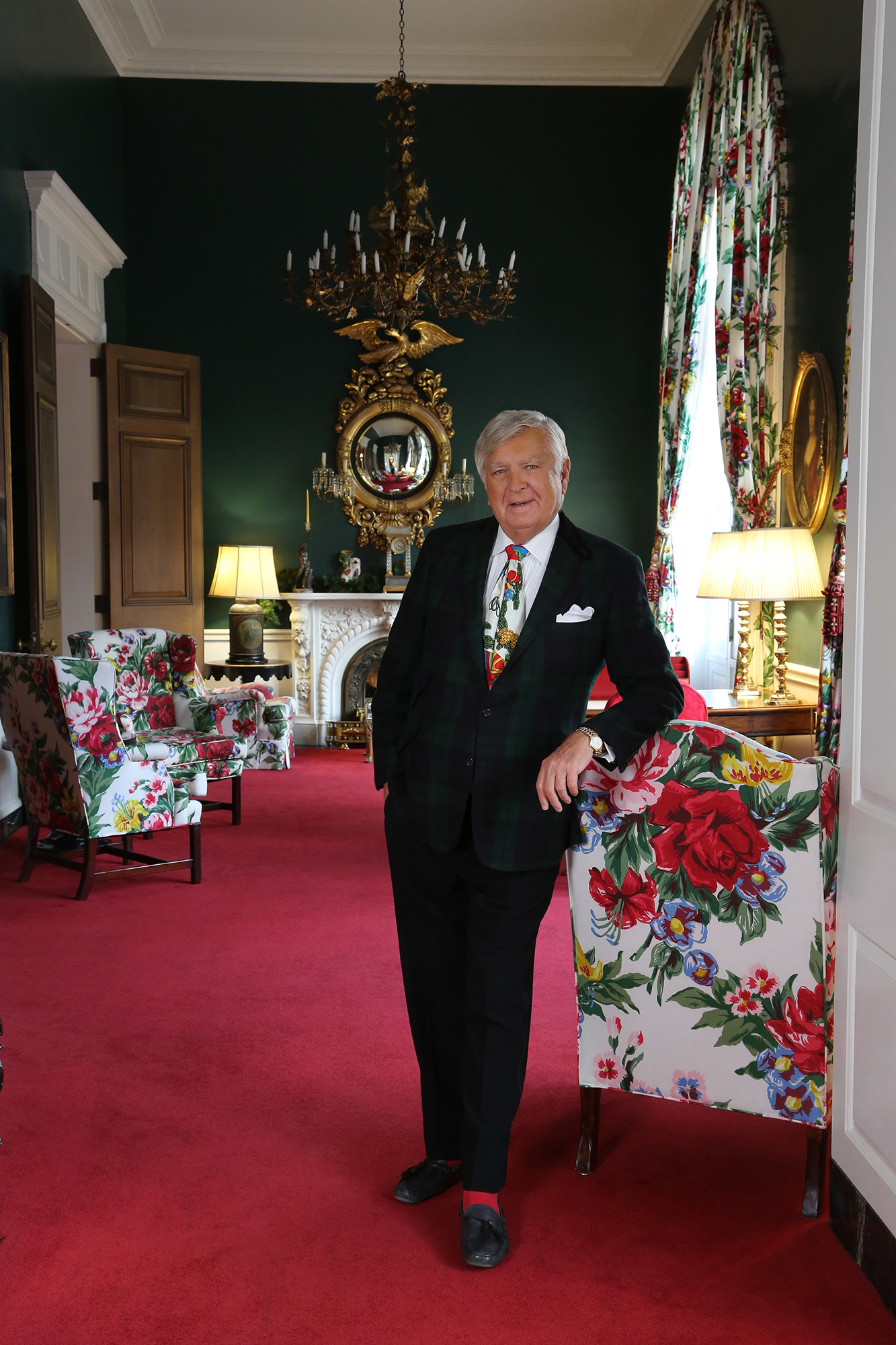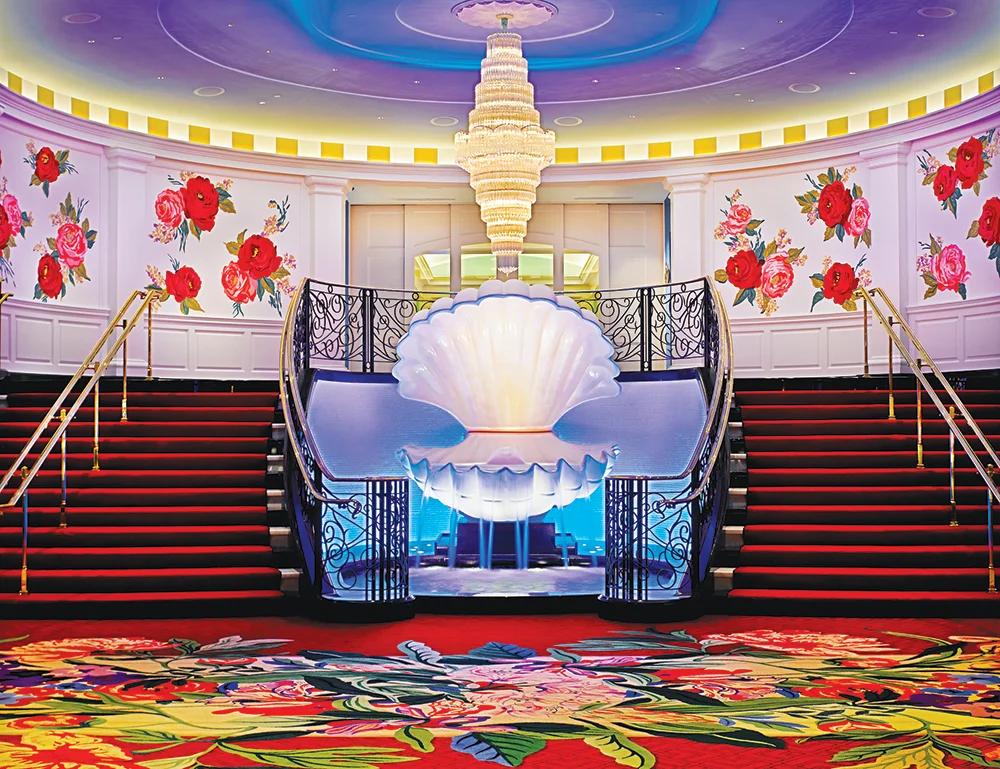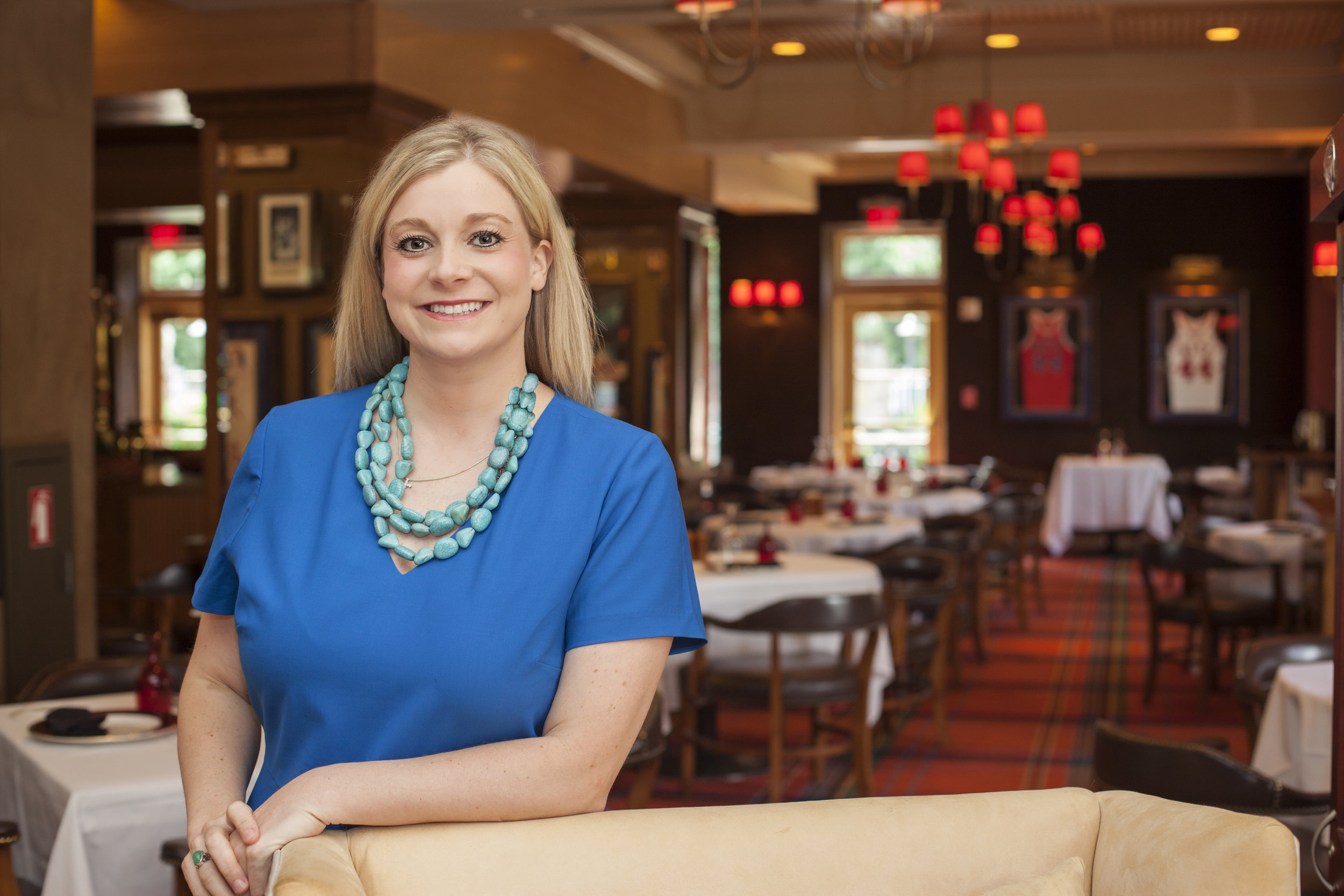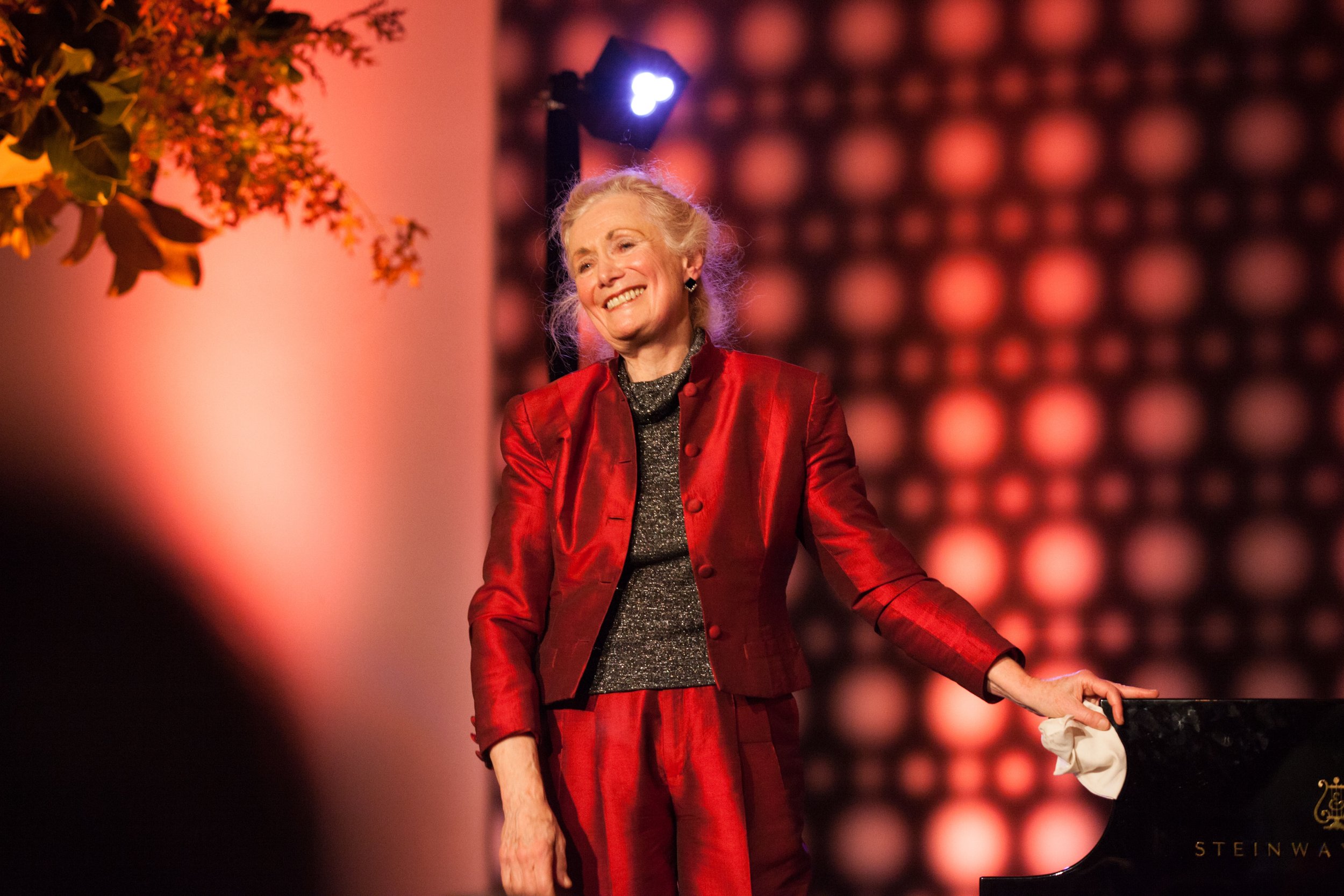A Conversation with Carleton Varney

BY GREG JOHNSON
If it seems like Carleton Varney knows everybody, it’s because he knows everybody. When other people mention their celebrity friends, or the king of this nation or prince of that one, chances are they’re either name-dropping or engaging in a little harmless exaggeration. In Carleton Varney’s case they really are friends, and often clients.
Varney has lived a life filled with glitz and glamour, usually of his own design. He’s written 34 books, hosted countless TV shows, and put his signature touches on landmarks ranging from the Waldorf Astoria to the Vice President’s official residence. He sells furniture, lighting, dinnerware, crystal, linens, fabrics and more. At age 79 he shows no sign of slowing down. They’re even giving him a new office at The Greenbrier, where he has enjoyed a 53-year run as the resort’s decorator.
There was nothing in Carleton Varney’s boyhood in Nahant, Massachusetts, to suggest that he was going to rise to the pinnacle of a profession that wasn’t even a profession at the time. His father was a former minor league baseball player who owned a sporting goods store. Their relatives up in Maine ran factories. The only hint of what the future held in store was the way he found himself fascinated by colors and designs when he watered his mother’s flower garden.
He attended Oberlin College in Ohio on a scholarship, earned a degree in Spanish, then taught briefly at the New Rochelle Academy in New York, a private school known for its foreign language study. His career path took an abrupt U-turn when a decorator friend suggested he try for a job with Dorothy Draper, a woman many consider the most influential interior designer of her era, and a creative genius. He was still in his early 20s and he’d never heard of Draper, but the next thing he knew he was studying interior design at the knee of the grand dame and decorating the residence of screen legend Joan Crawford. He’s been on a roll ever since.
Carleton Varney in front of The Greenbrier Chapel. Photo by Mike Wyatt of Greenbrier Photo.
Varney considers Draper and Crawford his two strongest influences. The Draper look lives on in his splashy, colorful, exuberant designs. It was from DD, as she took to styling herself, that he learned the invaluable lesson that he could turn himself into a brand by licensing the use of his name on product lines. Crawford’s influences, while less obvious, have proven every bit as helpful. “Always remember, Carleton,” the actress once told him, “I invented me, and you can invent you.”
Invent he did. The baseball player’s son became “Mr. Color,” dressing himself in lime greens and pinks and purples and reds, and adopting a scarf-worn-as-a-tie signature fashion statement. Scarves are typically worn around the neck, but men rarely tuck them under their collars and knot them in the style of regular ties like Mr. Color.
Carleton Varney brought something else to the table: personal charm. His mentor was so focused on her own vision that her clients quickly learned she wasn’t interested in their suggestions or preferences, particularly when it came to her flamboyant color choices. She even had a clause in her contracts specifying that she was to be the sole arbiter of taste in any project. Varney, on the other hand, was a people-person who showed genuine interest in his clients. He established a comfortable rapport with them. Instead of imposing his design ideas, he sold them.
His evolution from working for an icon to being one began when he became the president of Dorothy Draper & Company, a title he still holds today. In his long career at the helm of the legendary company, he has restored and decorated countless hotels, resorts, castles, cruise ships and private residences around the world. His resume is so lengthy that many articles about him consist of little more than a recitation of it with some quotes appended. Given his half-century relationship with The Greenbrier, we wanted to dig a little deeper with the famous decorator and pose a few questions he might not often hear.
GVQ: How do you explain the son of a father with a sporting goods store going into interior design?
CV: It does sound ironic, doesn’t it? The last thing a father in those days would have wanted was to introduce “my son, the decorator.” Our parents exposed my sister and me to beautiful things at an early age and made us aware of the natural and manmade beauty around us. I think that was the start of it.
GVQ: There weren’t any programs for interior design when you went to college, but somehow you found your calling.
CV: I believe, and Dorothy Draper believed, that great decorators are born, not trained. Millions of people can do pretty rooms, but very few can create an identifiable look. Frank Lloyd Wright did it, and so did Dorothy Draper. It’s about having an innate sense of color and design, an eye for what looks right. You either have it or you don’t. You can’t take a college class and get it. One of DD’s favorite sayings was, “If it looks right, it is right.” Of course she meant if it looked right to her. She didn’t really care about what other people wanted. The fact that they were paying for her services didn’t influence her. She was already wealthy and she didn’t care about the money. She was driven purely by her own taste. She wanted to create something fresh and new.
GVQ: It was your good luck that you happened to be hired by a genius.
CV: I know—I got on a merry-go-round that was already turning. From Day One we had instant recognition for everything we did.
GVQ: Do you ever think that if it hadn’t been for Dorothy Draper, you’d be a retired elementary or high school teacher?
CV: I was a popular teacher—I believed in giving everybody A’s. I always wanted the students at the bottom of the class to catch on, so I kept repeating things until they did. The three secrets of learning are 1) Repetition, 2) Repetition and 3) Repetition. No one was left back. That’s how I taught. They all succeeded.
GVQ: So you were the one who came up with No Child Left Behind?
CV: Maybe so! I’ve never stopped being a teacher. I’ve taught decorating classes all over the world. I’m comfortable in that role.
GVQ: People are so interested in talking with you about your designs or the famous people you’ve known that you’re rarely asked about your entrepreneurial side. It’s obvious you’ve got a knack for business.
CV: I’ve always understood that we have to keep filling the piggy bank. I’ve created streams of revenue. No one stream is most important, but together they create a river. I’ve licensed my name for everything from fabrics to cookies. I have six separate companies that are all variations on a theme. Directly or indirectly I employ about 60 people. My books do well, too. I’m able to promote them with my TV appearances and lecture tours.
GVQ: Speaking of your books, you’ve written two novels. What inspired you to take the time to write novels?
CV: It gave me a chance to create characters based on some of the interesting personalities I’ve known and worked with. The main character in my novel The Decorator is based at least in part on Joan Crawford.
GVQ: Let’s talk about The Greenbrier. The resort is Dorothy Draper’s best-known project, and probably yours, too. It’s always first on your long list of accomplishments.
CV: The Greenbrier is the most complete surviving example of the Draper style. DD’s remake of the hotel was total. She designed the matchbook covers, the menus, the uniforms and the bedspreads. She liked to say, “Show me nothing that looks like gravy,” meaning browns and grays and beiges. There’s no gravy at The Greenbrier. I feel the same way she did about color. Things that aren’t colorful depress me. I like spirited rooms and spirited people.
GVQ: Do you have a favorite project here?
CV: In the long run I think my greatest legacy will be the stained glass windows in the chapel. They’re filled with West Virginia elements—the sky, the mountains, the woods, the water, the animals. The windows help make the chapel the beautiful space it is. They’re inspirational without being specific to any religion.
GVQ: What sets The Greenbrier apart from other hotels?
CV: So many hotels today have manufactured glamour. It feels artificial. The Greenbrier has real glamour and an enormous historical element. It respects its own history. For a while I was afraid it was going to go in the direction of being like the Washington Marriott, which would have been a huge mistake. Jim Justice rescued it. The hotel is better cared for now that it has been at any time in my career.
GVQ: One of your other favorite projects is The Grand Hotel, on Mackinac Island in Michigan. What are the differences between the two famous resorts?
CV: They’re both family-owned, but The Grand Hotel is smaller, on an island without cars. It’s like being on a big cruise ship. It’s a summer place, with lots of wicker. The Grand Hotel is geraniums and marigolds. The Greenbrier is rhododendrons and roses. There’s only one Greenbrier.
GVQ: You’ve had a longer relationship with the hotel than Dorothy Draper did. You’ve decided to maintain her one-of-a-kind look and honor her legacy. You could have taken the resort in a completely different direction.
CV: It wouldn’t have made sense artistically or historically. I have plenty of other ways to show my versatility.
GVQ: And you’ve taken advantage of all of them in your own colorful way.
CV: People tend to become conservative as they get older. They lose the freedom of being a child with a paintbox. I don’t ever want to lose that freedom.









